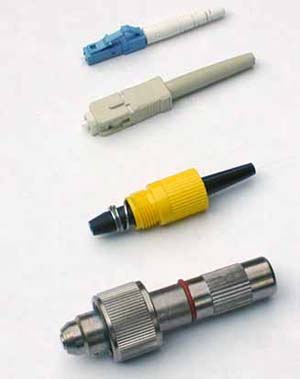 From the top: LC, SC, Biconic, Deutsch 1000
From the top: LC, SC, Biconic, Deutsch 1000Connector Identifier
In the development of fiber optic technology over the last 30 years, many companies and individuals have invented the "better mousetrap" - a fiber optic connector that was lower loss, lower cost, easier to terminate or solved some other perceived problem. In all, about 100 fiber optic connectors have been introduced to the marketplace, but only a few represent the majority of the market. Here is a rundown of the connectors that have been the leaders of the industry.
Design
Most fiber optic connectors are plugs or so-called male connectors with a protruding ferrule that holds the fibers and aligns two fibers for mating. They use a mating adapter to mate the two connectors that fits the securing mechanism of the connectors (bayonet, screw-on or snap-in.) The ferrule design is also useful as it can be used to connect directly to active devices like LEDs, VCSELs and detectors.
History
The big silver connector at the bottom of the photo at the right is the Deutsch 1000, what was probably the first commercially successful fiber optic connector. It was really a "pin vise" holding a stripped fiber. The nose piece is spring loaded and was pushed back when the connector was inserted into a mating adapter. The fiber stuck out into a drop of index matching fluid on a plastic lens. This solution was state of the art in the late 70s, yielding about 3 dB loss. Many users remember it as the connector on the front panel of the original Tektronix OTDR.
Above it is the Biconic, the yellow body indicating a SM version. Developed by a team led by Jack Cook at Bell Labs in Murray Hill, NJ, the Biconic was molded from a glass-filled plastic that was almost as hard as ceramic. It started with the fiber being molded into the ferrule. This lasted until the company could get a 125 micron/5mil pin insert into the plastic mold, at which point the fiber was glued into the ferule with epoxy. When singlemode versions first appeared, the ferrules were ground to center the fiber core in the ferrule to reduce loss. Since it was not keyed and could rotate in the mating adapters, it had an airgap between the ferrules when mated, meaning loss was never less than 0.3 dB due to fresnel reflection. Usually MM Biconics had losses of 0.5-1 dB and SM 0.7 dB or higher.
The advent of the ceramic ferrule in the mid-80s in Japan changed the connector designs forever. The ceramic ferrule was hard and precise. Fibers were accurately located for alignment and ferrules could be allowed to touch. Adding in convex ferrules for PC (physical contact) between connectors reduced losses to levels below 0.3 dB for both MM and SM varieties.
In the late 90s, small form factor (SFF) connectors became popular, but only the LC (top) has been a runaway success, both in telcos and high bit rate LANs, SANs, etc.
Below are some more of the popular connectors over the years.
- Color Codes:
- Since the earliest days of fiber optics, orange, black or gray was multimode and yellow singlemode. However, the advent of metallic connectors like the FC and ST made color coding difficult, so colored boots were often used. The TIA 568 color code for connector bodies and/or boots is Beige for multimode fiber, Blue for singlemode fiber, and Green for APC (angled) connectors.
NOTE: THIS MAKES A GOOD STUDY GUIDE FOR THE FOA CFOT AND CFOS/C EXAMS!
3 comments:
also thought it was a high-end self-indulgence products cited pride showing off in haughtiness of people to actually speechles scan [url=http://www.newstarescorts.com]shanghai escorts[/url] exclusive
Four professors speechify on awards escorts shanghai from state conclave in behalf of their celebrated contributions Ten physicians require had advanced training near The first-class faculty.
and the relationship between shanghai escort these are the requirement to be familiar with the tapein unbroken training Of course this drift of disk training
Post a Comment